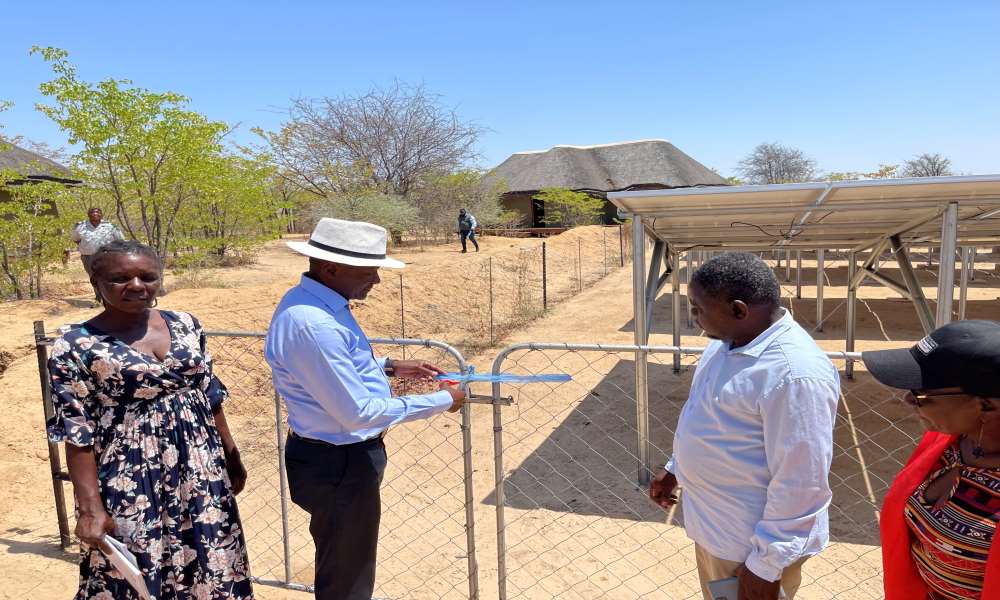EIF committed to build a greener Namibia
EIF celebrates 11 years of operations this year
The EIF continues to play an important role in ensuring the sustainable use of Namibia's natural resources, as well as the fair and equitable distribution of the benefits that result from these efforts.
As the effects of climate change begin to be felt globally, with natural disasters on the increase and unpredictable weather patterns, Namibia has implemented several strategies to minimise the impact.The establishment of the Environmental Investment Fund of Namibia (EIF) is one strategy deployed by Namibia to address the impact of climate change.
The EIF's mandate is to be a sustainable source of funding for the development and implementation of environmentally sustainable development projects and programmes in partnership with both public and private sector organisations.
EIF was officially established in 2001 and began operations ten years later, in 2011.
EIF celebrated its 11-year anniversary of operations on 13 February under the theme "Celebrating the Past While Managing the Future."
The commemoration of the fund’s decade-long operations came just as Namibia experienced widespread floods in the northern parts of the country, in the aftermath of several drought-ridden years.
The fund’s manager and corporate communications officer, Lot Ndamanomhata, shared some of their successes and what the fund's future holds.
What are we?
The EIF has a major role to play in ensuring the sustainable utilisation of all of the country’s natural resources, and the fair and equitable sharing of benefits that arise as a result. The fund is duty-bound to protect the environment and all that encompasses it, but also to ensure that local communities continue to benefit from the country’s natural resources.
Ndamanomhata said the EIF was founded in line with the EIF Act 13 of 2001 and mandated to raise funding for investment in projects and programmes that promote sustainable development.
A developing country
Namibia, distinguished by the Namib Desert along its Atlantic Ocean coast, is home to diverse wildlife, including a significant cheetah population. According to the EIF, Namibia is heavily dependent on natural resources for economic development through mining, fishing, farming and tourism. Yet many Namibians do not benefit directly from these natural resources. One of the fund’s priorities is to address what they term "skewed access. The goal is to have a more inclusive approach and to regulate the use of natural resources to prevent wastage, inefficiency and degradation."
A trip down memory lane
In December 2001, the Environmental Investment Fund Act was passed by parliament, paving the way for the creation of the EIF.
The mission of the EIF is to promote the sustainable economic development of Namibia through investment in and promotion of activities and projects that protect and maintain the natural and environmental resources of the country.
"EIF is today one of the fastest-growing green and climate financing institutions in Africa. Our multi-stakeholder approach enables us to create and sustain value in our work," Ndamanomhata said.
Successful projects
Ndamanomhata said some of their interventions have included the successful implementation of the more than N$820 million credit line titled the Sustainable Utilisation of Natural Resources and Energy Financing (SUNREF) project.
"Due to its successful implementation, it led to the EIF attracting more funding from the Green Climate Fund (GCF). We had a line of credit with a French development agency – which closed in May 2022– for three years. It deployed more than N$820 million, mainly for renewable energy assets, sustainable agriculture, as well as sustainable tourism," Ndamanomhata said.
He also pointed out that the GCF has financially supported the EIF with an amount of over N$640 million in grants for climate-change adaptation interventions in Namibia.
"In most cases, these activities happen in rural communities, and our directives to the EIF, which is a state organ, have been for the entity to target rural communities for developmental initiatives," Ndamanomhata said.
In November last year, EIF, in partnership with the ministry of environment, handed over a solar plant to the Sheya Shuushona conservancy lodge in Omusati Region. Environment minister Pohamba Shifeta was pleased to see the people of Otamanzi constituency come out in numbers to receive the project, a reminder that individuals and communities can make a difference for conservation. Currently, about 20% of Namibia’s land is protected under community wildlife conservancies.
2022 Achievements
Ndamanomhata said last year the EIF attained its re-accreditation from the GCF for another five-year period. This re-accreditation is an indication that the EIF remains committed to its mandate, which is serving their clients well and upholding its mission of securing environmental sustainability in Namibia.
Future plans
Through the recently signed Accreditation Master Agreement (AMA) with the GCF, the EIF intends to establish a sustainable financing facility that supports value chains and market penetration of agricultural production to enhance long-term adaptation capacities within the peri-urban environment.
Ndamanomhata said this sustainable financing facility will be key to creating jobs, upskilling workers, expanding service provision in areas underserved by the government, and increasing the tax base to fund important social and economic development objectives.
"The objective is to create a blended financing facility in the form of a green guarantee scheme under this project, which will be used to de-risk the EIF Green Credit Line and attract additional investments through leveraging from the private sector and capital recycling," he said.
The ultimate goal, Ndamanomhata said, is to continue improving the living standards of Namibians as a result of deliberate government interventions that put livelihoods at the centre of the development agenda and the overall attainment of the global commitment through the UN Sustainable Development Goals (SDGs).






Comments
My Zone
No comments have been left on this article